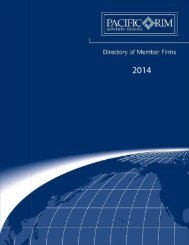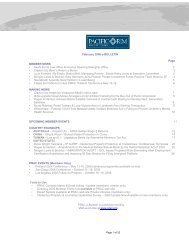A Guide to the Law of Securitisation in Australia - Clayton Utz
A Guide to the Law of Securitisation in Australia - Clayton Utz
A Guide to the Law of Securitisation in Australia - Clayton Utz
- No tags were found...
You also want an ePaper? Increase the reach of your titles
YUMPU automatically turns print PDFs into web optimized ePapers that Google loves.
An <strong>in</strong>ves<strong>to</strong>r <strong>in</strong> turn receives an acknowledgement <strong>in</strong> writ<strong>in</strong>g from<strong>the</strong> person ma<strong>in</strong>ta<strong>in</strong><strong>in</strong>g <strong>the</strong> register, confirm<strong>in</strong>g that <strong>the</strong> <strong>in</strong>ves<strong>to</strong>rappears <strong>in</strong> <strong>the</strong> register as <strong>the</strong> holder <strong>of</strong> particular securities.Under this type <strong>of</strong> arrangement, <strong>the</strong> <strong>in</strong>ves<strong>to</strong>r does not hold a true.debt <strong>in</strong>strument. However, little (if any) legal importance turns on<strong>the</strong> dist<strong>in</strong>ction. It is simply ano<strong>the</strong>r accepted method <strong>of</strong> issu<strong>in</strong>gdebt securities. A transfer <strong>of</strong> a registered security occurs by <strong>the</strong>transferor and <strong>the</strong> transferee execut<strong>in</strong>g a Transfer andAcceptance Form and <strong>the</strong>n lodg<strong>in</strong>g this with <strong>the</strong> registrar.Sometimes (depend<strong>in</strong>g on <strong>the</strong> requirements <strong>of</strong> <strong>the</strong> underly<strong>in</strong>gdocuments), this must be accompanied by <strong>the</strong> orig<strong>in</strong>alconfirmation. Although this is not strictly necessary, it is adesirable practice <strong>to</strong> avoid fraud.The transfer is effective as between <strong>the</strong> transferor and <strong>the</strong>transferee upon <strong>the</strong> execution <strong>of</strong> <strong>the</strong> Transfer and AcceptanceForm and payment by <strong>the</strong> transferee <strong>of</strong> <strong>the</strong> purchase price (andupon performance <strong>of</strong> any o<strong>the</strong>r conditions precedent that may bestipulated by <strong>the</strong> parties as part <strong>of</strong> <strong>the</strong> transfer). But, as far as<strong>the</strong> issuer is concerned, <strong>the</strong> transfer does not become effectiveuntil <strong>the</strong> transferee is noted <strong>in</strong> <strong>the</strong> register as <strong>the</strong> holder <strong>of</strong> <strong>the</strong>securities. Until this occurs, <strong>the</strong> issuer is entitled <strong>to</strong> onlyrecognise <strong>the</strong> transferor as <strong>the</strong> holder and all payments, notices,etc. are made <strong>in</strong> <strong>the</strong> <strong>in</strong>terim <strong>to</strong> <strong>the</strong> transferor.In <strong>Australia</strong>, almost all securitised <strong>in</strong>struments are structured asregistered securities. As most securities are held and tradedthrough Austraclear, typically <strong>the</strong> register <strong>of</strong> an issu<strong>in</strong>g vehiclewill show Austraclear as <strong>the</strong> only holder <strong>of</strong> its securities.Austraclear <strong>the</strong>n keeps its own record <strong>of</strong> those on whose behalfit is hold<strong>in</strong>g those securities <strong>in</strong> <strong>the</strong> Austraclear System.1.3.4 The enforceability <strong>of</strong> registered securitiesAt general law, <strong>the</strong>re is a pr<strong>in</strong>ciple known as privity <strong>of</strong> contract.This means that only <strong>the</strong> parties <strong>to</strong> a contract can enforce it.With registered securities, <strong>in</strong>ves<strong>to</strong>rs are not a party <strong>to</strong> <strong>the</strong><strong>in</strong>strument creat<strong>in</strong>g <strong>the</strong> debt obligation represented by <strong>the</strong>irsecurities. This <strong>the</strong>n raises <strong>the</strong> issue <strong>of</strong> how do <strong>the</strong>y enforce <strong>the</strong>issuer’s promise <strong>to</strong> pay <strong>in</strong>terest and pr<strong>in</strong>cipal, when <strong>the</strong>y cannotsatisfy <strong>the</strong> privity <strong>of</strong> contract rule?Where <strong>the</strong> issuer is a special purpose corporation, a note trustdeed or a deed poll is usually used. Both <strong>of</strong> <strong>the</strong>se employexceptions <strong>to</strong> <strong>the</strong> privity rule. Under a note trust deed, <strong>the</strong> issuercovenants <strong>in</strong> favour <strong>of</strong> a note trustee that it will pay <strong>in</strong>terest andpr<strong>in</strong>cipal on its debt securities. This covenant is held on trust by<strong>the</strong> note trustee for <strong>the</strong> benefit <strong>of</strong> <strong>the</strong> holders <strong>of</strong> <strong>the</strong> registeredsecurities from time <strong>to</strong> time.Although <strong>the</strong> holders <strong>of</strong> <strong>the</strong> securities are not parties <strong>to</strong> <strong>the</strong> notetrust deed and so cannot directly enforce <strong>the</strong> issuer’s covenant,<strong>the</strong>y are beneficiaries <strong>of</strong> <strong>the</strong> trust and can require <strong>the</strong> notetrustee <strong>to</strong> do so.Under a deed poll, <strong>the</strong> issuer’s covenants are made <strong>in</strong> favour <strong>of</strong><strong>the</strong> registered security holders from time <strong>to</strong> time. The exact legalnature <strong>of</strong> a deed poll has been <strong>the</strong> subject <strong>of</strong> much legal debatebut, notwithstand<strong>in</strong>g this, deeds poll are frequently used <strong>in</strong> <strong>the</strong>market.The position is more <strong>in</strong>terest<strong>in</strong>g where <strong>the</strong> issuer is a trustee. Inalmost all <strong>Australia</strong>n securitisations, <strong>the</strong> trustee’s promise <strong>to</strong> pay<strong>in</strong>terest and pr<strong>in</strong>cipal on its debt securities is conta<strong>in</strong>ed <strong>in</strong> <strong>the</strong>trust deed. However, <strong>the</strong> trustee’s obligations <strong>in</strong> a trust deedusually can only be enforced by <strong>the</strong> beneficiary (or beneficiaries)<strong>of</strong> <strong>the</strong> relevant trust. How <strong>the</strong>n do <strong>the</strong> holders <strong>of</strong> <strong>the</strong> securitieshave <strong>the</strong> benefit <strong>of</strong> <strong>the</strong> trustee’s promise <strong>to</strong> pay <strong>in</strong>terest andpr<strong>in</strong>cipal on <strong>the</strong>ir securities?The answer lies <strong>in</strong> <strong>the</strong> fact that with <strong>the</strong>se structures <strong>the</strong>re isalways a security trust deed. Under <strong>the</strong> security trust deed, <strong>the</strong>issu<strong>in</strong>g trustee covenants <strong>in</strong> favour <strong>of</strong> a security trustee that itwill pay <strong>in</strong>terest and pr<strong>in</strong>cipal on <strong>the</strong> registered securities <strong>in</strong>accordance with <strong>the</strong> trust deed. As with a note trust deedarrangement, <strong>the</strong> security trustee holds <strong>the</strong> benefit <strong>of</strong> thiscovenant on trust for <strong>the</strong> security holders. They can enforce <strong>the</strong>terms <strong>of</strong> <strong>the</strong>ir debt securities through <strong>the</strong> security trust deed.If <strong>in</strong> <strong>the</strong> future <strong>the</strong>re is ever a proposal for a trustee <strong>to</strong> issueunsecured registered securities, <strong>the</strong> legal basis for <strong>the</strong>irenforceability will need <strong>to</strong> be exam<strong>in</strong>ed at that time <strong>in</strong> greaterdetail. In particular, it may be necessary <strong>to</strong> put <strong>in</strong> place a deedpoll or a note trust deed <strong>to</strong> address this issue.1.4 ConclusionThe securities held by <strong>in</strong>ves<strong>to</strong>rs <strong>in</strong> <strong>the</strong> <strong>Australia</strong>n securitisedmarket tend <strong>to</strong> be exclusively debt securities ra<strong>the</strong>r than equitysecurities. The former are issued ei<strong>the</strong>r by special purposecorporations or by trustees. Where a special purpose vehicleissues debt securities, traditional legal forms are used. However,<strong>the</strong> issue <strong>of</strong> debt securities by trustees, which is largely conf<strong>in</strong>ed<strong>to</strong> <strong>the</strong> <strong>Australia</strong>n market place, raises a number <strong>of</strong> unique issues.These are canvassed <strong>in</strong> section 10.The next section <strong>of</strong> this publication exam<strong>in</strong>es <strong>the</strong> classificationand regulation <strong>of</strong> debt and equity securities under <strong>the</strong>Corporations Act.9






